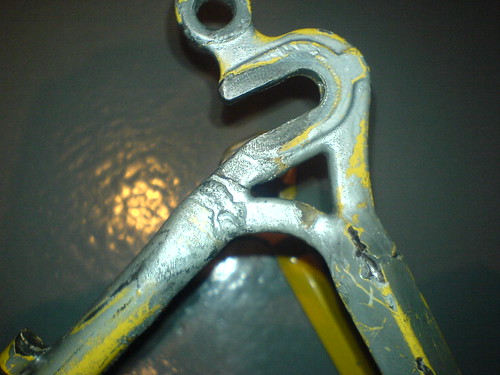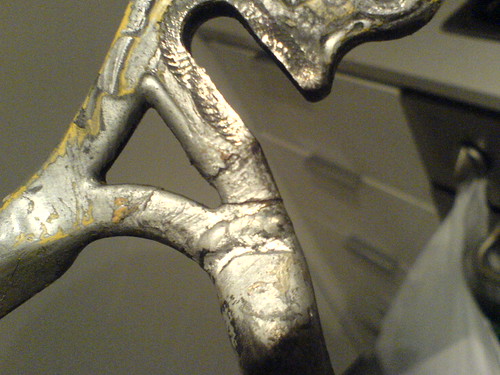So my 753 fillet braised commuter has cracked again (across the drive side dropout), I still really like this bike, anyone got suggestions regarding repairs?
If it’s just the dropout you can get them un-brazed, and have new ones on. Not sure who does this these days, Abbotsford cycles perhaps? And some guys out of the city I think.
abottsford do, someone had it done, mentioned it was approx $150-170 i think?
753 and fillet brazed is not a good combination theoretically…
Paconi did a fairly tidy job when JP broke his scapin drive side drop out, dont think it was all that x’y either.
SP
Silver brazed is pretty common with 753.
The GRIPSPORT guys reckon they can fix anything. Might be worth a call.
actually, this was to replace both dropouts, so i guess for only one, it would be half the price, hey?
Silver brazed and lugged was the only way Reynolds would certify 753 builders.
Not sure what your comment was saying, 753 was used in both fillet brazed and lugged (which are always brazed), to use 753 you had to be accredited, very strong but heat sensative hence silver based brazing, fillets or lugs.
Ag brazing alloys can melt as low as 550ºC, Cu-Zn alloys can be as high as 900ºC. 4130 (Cr-Mo, similar to Mn-Mo (531) melts at ~1430ºC, is annealed at 400-565ºC and is tempered at ~840ºC.
If you take 531 and heat treat it, you end up with 753, which has a yield strength 1.5x that of 531 (695 vs 1040 MPa), allowing you to use thinner walls for the same load carrying capacity with the bonus of lower weight. So you’d be undoing the heat treatment with brass brazing by over tempering.
Additionally, brass brazing will result in a larger distance from the joint being overheated and weakened compared to silver.
The strengths of Cu-Zn and Ag brazing alloys are similar (400-450MPa). I don’t know how the strength of a fillet compares to a lug, or the difficulty/time in brazing a fillet vs a lug in silver, which is what this discussion is centred around. Presumably lugged is stronger as there is a larger ‘lap’ joint and possibly there is less time spent at temperature due to not having to build a fillet. But I’m just guessing.
Reynolds were obviously keen on the builders being able to braze at low temps without weakening too much of the tubing, hence the certification. I’ll let someone with more experience chime in on why silver-fillet brazing is not favoured.
So my 753 fillet braised commuter has cracked again (across the drive side dropout), I still really like this bike, anyone got suggestions regarding repairs?
Call John Bosevski http://www.cycleunderground.com.au/framerepairs.htm
He can sort out some shipping to if you live interstate
4130 (Cr-Mo, similar to Mn-Mo (531) melts at ~1430ºC, is annealed at 400-565ºC and is tempered at ~840ºC.
isn’t it the other way round?
Not sure what your comment was saying, 753 was used in both fillet brazed and lugged (which are always brazed), to use 753 you had to be accredited, very strong but heat sensative hence silver based brazing, fillets or lugs.
I meant exactly what I said. Reynolds only certified framebuilders who supplied examples of (initially complete frames, later just a test piece) silver-brazed, lugged joints. Framebuilders could use whatever joining method they liked to build bikes (and they did) but Reynolds only certified framebuilders based on lugged joints. Some framebuilders tried submitting both welded and lugless joints but Reynolds would not accept the items for testing and certification.
[quote=Blakey ]4130 (Cr-Mo, similar to Mn-Mo (531) melts at ~1430ºC, is annealed at 400-565ºC and is tempered at ~840ºC.
isn’t it the other way round?
[/quote]
Nope.
UK was short on Cr, so they produced Mn-Mo.
Oh. Wait. You mean the annealing/tempering.
Crap. Yeah, wrong way around, you’re right.
Jesse at the Bike Bar suggested that I master fillet brazing with silver before considering doing any frame building. I didn’t take his advice, but if he’s right, it does mean that some people can fillet braze with silver, thus keeping the temperature down, and, presumably it means he himself can do it and might be a good person to talk to about the repair.
So after this bg discussion it is actually 731 OS Race tube set (apart form some funky square seat stays)
Crack ( both sides of dropout)


Seat stays
h

Replace the dropout (or both of them), the heat from the previous dropout repair (and this one, if carried out) can’t be helping the fatigue life of the dropout.